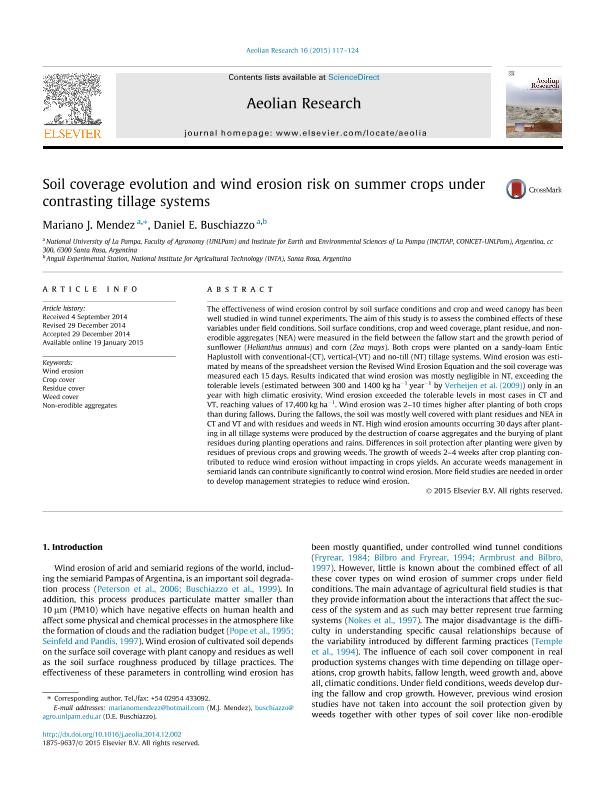Mostrar el registro sencillo del ítem
dc.contributor.author
Mendez, Mariano Javier

dc.contributor.author
Buschiazzo, Daniel Eduardo

dc.date.available
2019-08-12T21:19:59Z
dc.date.issued
2015-03
dc.identifier.citation
Mendez, Mariano Javier; Buschiazzo, Daniel Eduardo; Soil coverage evolution and wind erosion risk on summer crops under contrasting tillage systems; Elsevier; Aeolian Research; 16; 3-2015; 117-124
dc.identifier.issn
1875-9637
dc.identifier.uri
http://hdl.handle.net/11336/81522
dc.description.abstract
The effectiveness of wind erosion control by soil surface conditions and crop and weed canopy has been well studied in wind tunnel experiments. The aim of this study is to assess the combined effects of these variables under field conditions. Soil surface conditions, crop and weed coverage, plant residue, and non-erodible aggregates (NEA) were measured in the field between the fallow start and the growth period of sunflower (Helianthus annuus) and corn (Zea mays). Both crops were planted on a sandy-loam Entic Haplustoll with conventional-(CT), vertical-(VT) and no-till (NT) tillage systems. Wind erosion was estimated by means of the spreadsheet version the Revised Wind Erosion Equation and the soil coverage was measured each 15days. Results indicated that wind erosion was mostly negligible in NT, exceeding the tolerable levels (estimated between 300 and 1400kgha-1year-1 by Verheijen et al. (2009)) only in an year with high climatic erosivity. Wind erosion exceeded the tolerable levels in most cases in CT and VT, reaching values of 17,400kgha-1. Wind erosion was 2-10 times higher after planting of both crops than during fallows. During the fallows, the soil was mostly well covered with plant residues and NEA in CT and VT and with residues and weeds in NT. High wind erosion amounts occurring 30days after planting in all tillage systems were produced by the destruction of coarse aggregates and the burying of plant residues during planting operations and rains. Differences in soil protection after planting were given by residues of previous crops and growing weeds. The growth of weeds 2-4weeks after crop planting contributed to reduce wind erosion without impacting in crops yields. An accurate weeds management in semiarid lands can contribute significantly to control wind erosion. More field studies are needed in order to develop management strategies to reduce wind erosion.
dc.format
application/pdf
dc.language.iso
eng
dc.publisher
Elsevier

dc.rights
info:eu-repo/semantics/openAccess
dc.rights.uri
https://creativecommons.org/licenses/by-nc-nd/2.5/ar/
dc.subject
Crop Cover
dc.subject
Non-Erodible Aggregates
dc.subject
Residue Cover
dc.subject
Weed Cover
dc.subject
Wind Erosion
dc.subject.classification
Otras Ciencias Agrícolas

dc.subject.classification
Otras Ciencias Agrícolas

dc.subject.classification
CIENCIAS AGRÍCOLAS

dc.title
Soil coverage evolution and wind erosion risk on summer crops under contrasting tillage systems
dc.type
info:eu-repo/semantics/article
dc.type
info:ar-repo/semantics/artículo
dc.type
info:eu-repo/semantics/publishedVersion
dc.date.updated
2019-08-12T13:40:28Z
dc.journal.volume
16
dc.journal.pagination
117-124
dc.journal.pais
Estados Unidos

dc.journal.ciudad
Lubbock
dc.description.fil
Fil: Mendez, Mariano Javier. Consejo Nacional de Investigaciones Científicas y Técnicas. Instituto de Ciencias de la Tierra y Ambientales de La Pampa. Universidad Nacional de La Pampa. Facultad de Ciencias Exactas y Naturales. Instituto de Ciencias de la Tierra y Ambientales de La Pampa; Argentina
dc.description.fil
Fil: Buschiazzo, Daniel Eduardo. Consejo Nacional de Investigaciones Científicas y Técnicas. Instituto de Ciencias de la Tierra y Ambientales de La Pampa. Universidad Nacional de La Pampa. Facultad de Ciencias Exactas y Naturales. Instituto de Ciencias de la Tierra y Ambientales de La Pampa; Argentina. Instituto Nacional de Tecnología Agropecuaria; Argentina
dc.journal.title
Aeolian Research
dc.relation.alternativeid
info:eu-repo/semantics/altIdentifier/url/https://www.sciencedirect.com/science/article/pii/S1875963715000026
dc.relation.alternativeid
info:eu-repo/semantics/altIdentifier/doi/https://doi.org/10.1016/j.aeolia.2014.12.002
Archivos asociados
